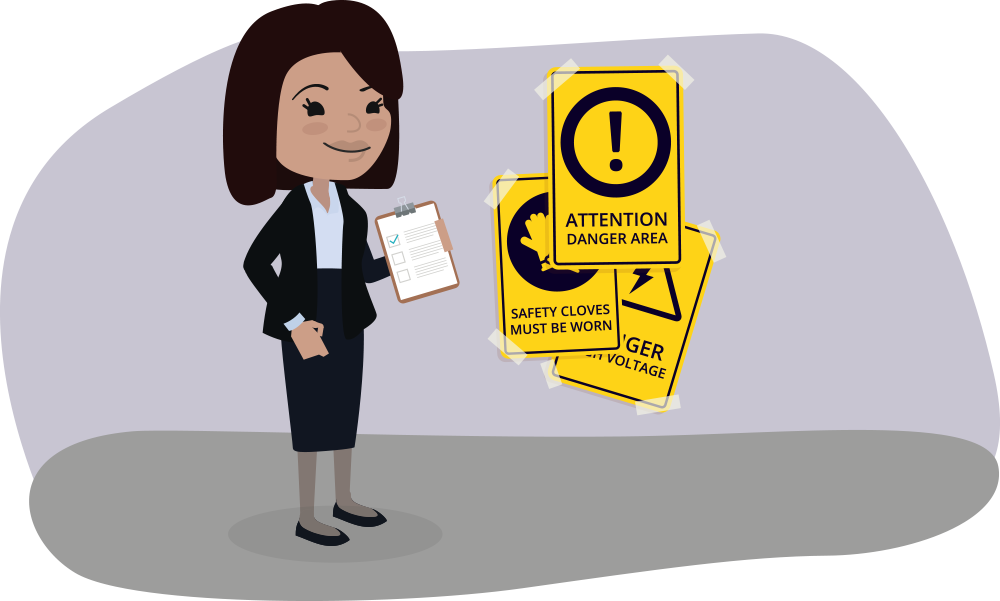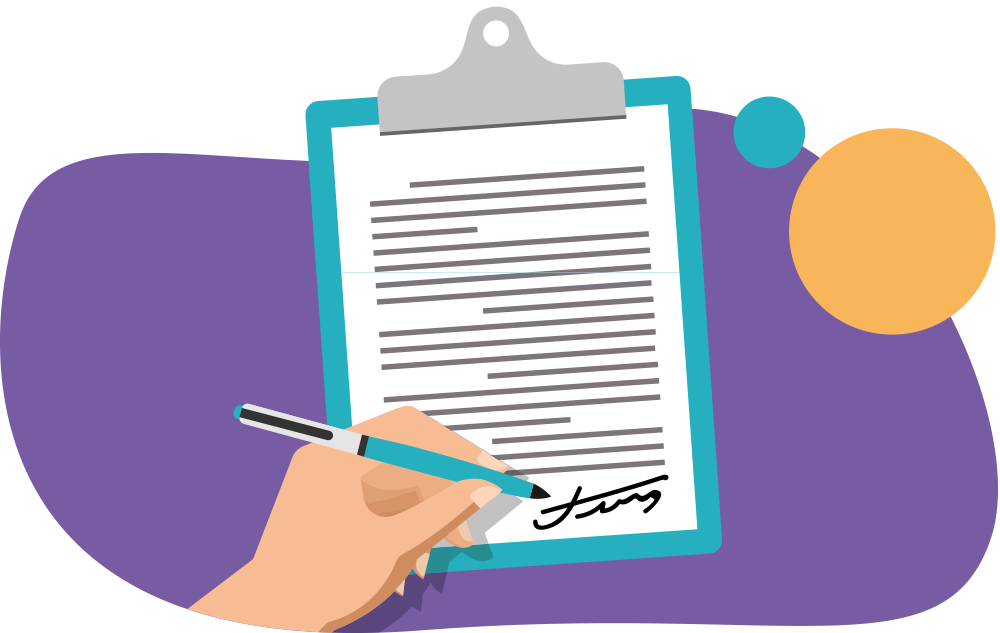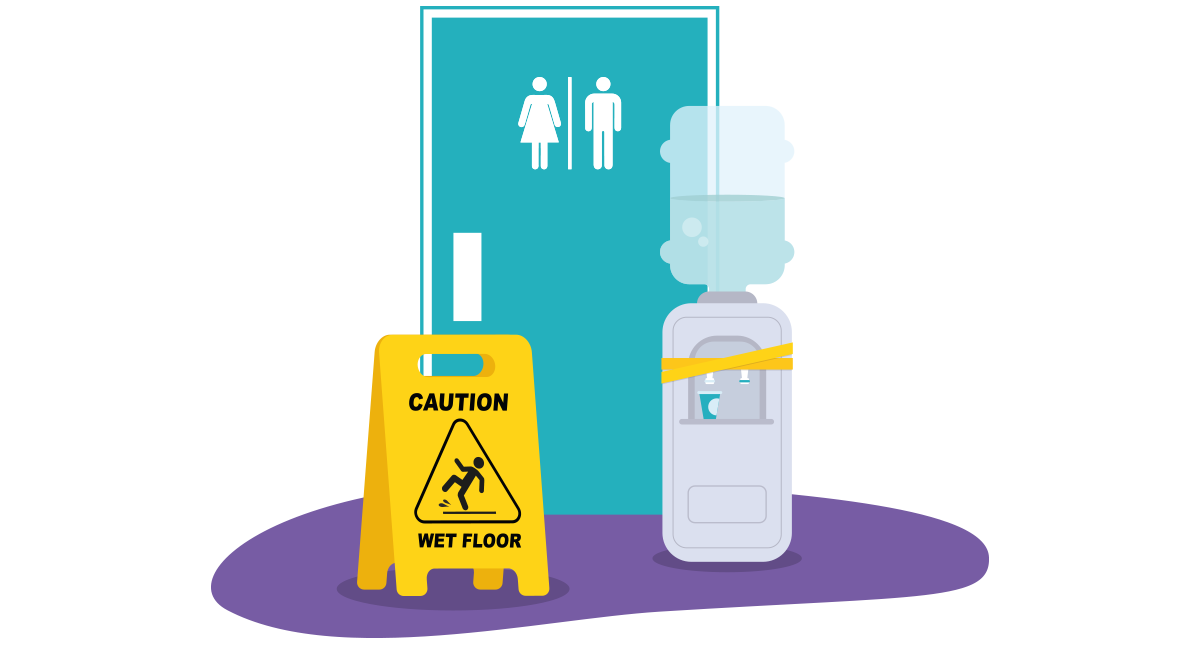Health and safety in the workplace –FREE guide!
An introduction to health and safety in the workplace
Keeping your staff safe from harm is one of your key duties as an employer but, with so much advice out there, it can be hard to keep on top of.
That’s why we’ve provided this handy guide to health and safety. We’ll look at why health and safety is important, what the laws are, and what practical steps you need to take to keep your team safe.
In writing this article, we’ve used some of our extensive experience keeping staff safe across a wide range of industries. However, this should only be seen as advice, not legal guidance.
Appoint a competent person to look after your health and safety
Someone needs to be in charge of your company’s health and safety. This competent person does not need qualifications or formal training in H&S, but they should at the least have a good understanding of your company and what your team does.
The ‘competent person’ may be yourself, a member of your team, or someone outside your business, but they need to understand what hazards your workers face so that they can help you take steps to keep your team safe.
If your company is large, complex, or performs high-risk work, you may want to seek external help, such as a health and safety consultant or adviser. If you do decide to go down this route, remember that managing a team’s health and safety is ultimately the duty of an employer.
Create a health and safety policy
What is a health and safety policy?
Health and safety policies don’t need to be complicated or difficult, but they are a legal requirement.
Your health and safety policy should set out what your approach is to health and safety, how you will manage the health and safety of your business, and what that means for how you and your team works.
You must share your health and safety policy with your team, including any updates that you make along the way.
If you have five or more employees, your H&S policy must be written down.
How to write a health and safety policy
Part 1: Statement of intent
State your general policy on health and safety at work, including your commitment to managing health and safety and your aims. As the employer or most senior person in the company, you should sign it and review it regularly.
Part 2: Responsibilities for health and safety
Make a list of who has specific health and safety responsibilities in your business, alongside their positions and roles.
These responsibilities may include those with ‘typical’ health and safety positions, such as first aiders and fire marshals, but also managers, team leaders, and any employee who has distinct health and safety responsibilities, such as supervising a high-risk colleague.
Part 3: Arrangements for health and safety
Explain the concrete, practical steps you are taking to achieve your health and safety aims. These steps may include making a risk assessment or providing your team with H&S training, or they may include the use of Personal protective equipment (PPE), tools, signage and other safety equipment.
When updating this document, we encourage you to communicate with your team, as they will have the best knowledge of the hazards and risks in their role.
For your convenience, we have created a free, easy to use health and safety policy builder which will guide you through each of these steps.
Risk assessments
Building a thorough, sensible and frequently updated risk assessment is, in our opinion, one of the most important first steps you can take to keep your staff safe and thus meet UK health and safety legislation.
Risk assessments are quite simple to carry out, but may take a little time and consideration. The simple process of building your risk assessment is:
Identify and assess the hazards (anything that could cause injury, such as objects, roles and behaviours) that your team faces. We’d strongly recommend you consult your staff during this process as they are likely to have the best knowledge of their daily process.
Work out how you can control the risks by removing hazards, changing behaviour, or providing new training or equipment.
If you cannot remove a hazard entirely, you should manage the risk so that ‘harm is unlikely’. The Health and Safety Executive (HSE) requires you to do everything you reasonably can to protect people from harm.Record your findings. If you employ five or more people, a risk assessment must be written down but, personally, we would recommend it for companies of any size. To make this process easier, we have a free risk assessment builder for you to use.
Review your risk assessment frequently. You should both check to see if your risk controls have been successful, and if any new risks have presented themselves.
There is also a growing interest in dynamic risk assessments, which enable staff to build and mould risk assessments around their changing circumstances. You can learn more about dynamic risk assessments, here.
First Aid
Overview of first aid
Employers must ensure that ‘employees get immediate help’ if they are injured or taken ill at work. This is a legal requirement for all workplaces, and for the self-employed.
To meet health and safety laws around first aid, you must:
keep an appropriately stocked first-aid kit
have an appointed person (or people) to handle first-aid matters
inform your employees about your first aid arrangements
What first aid is right for your organisation?
The UK’s health and safety executive requires businesses to provide ‘adequate and appropriate first aid arrangements’ but what that entails really depends on the sort of work you do.
When considering what level of first-aid arrangements, consider:
The type of work you do –level of risk, potential hazards, the size of your workforce and work environment, and your history of in-work incidents
The type of team you have –do you have at home workers, remote workers or lone workers? How accessible is your team in the case of an emergency? Do you need to provide first aid for the public?
Who will take charge of your first aid?
According to the HSE, ‘an appointed person must always be available whenever people are at work’. This person (or people) does not need to be a qualified first aider or to have any other formal training, but they must know your first aid procedures.
Again, when considering this, it’s important to consider people working different shifts, working remotely or on their own, and taking periods of absence.
What do I need to put in a first aid kit?
The makeup of your first aid kit(s) depends on the level of risk of your roles. An administrative office will likely have a less comprehensive first aid kit than, say, a building site.
At a minimum, the government suggests:
Some general guidance on first aid (such as HSE's Basic advice on first-aid at work leaflet)
Individually wrapped sterile plasters of assorted sizes
Sterile eye pads
Individually wrapped triangular bandages, preferably sterile
Safety pins
Large and medium-sized sterile, individually wrapped, unmedicated wound dressings
Disposable gloves
Make sure to replace the items as they get used, or as they reach their expiry date.
How many trained first aiders do I need?
There are no set rules for how many trained first aiders you need. As mentioned at the start of this section, your level of first aid should depend on the specifics of your organisation – level of risk, number of employees, etc.
Use your risk assessments to make these decisions.
Who should provide my first aid training?
For all businesses (apart from offshore work), the HSE only requires that first aid training is provided by someone who can ‘prove their competence’.
This means that an independent training provider may be perfectly acceptable for your business, but you may also choose to work with a training provider that has been recognised by your country’s government. To find out more about government recognised trainers for the UK, visit the HSE’s website.
When seeking first aid training, it may be helpful to know the different levels of training:
Emergency first aid at work – EFAW trained first aiders are qualified to give emergency first aid to someone who is injured or becomes ill while at work
First aid at work – FAW-trained first aiders are qualified to EFAW level but can also apply first aid to a range of specific injuries and illnesses
Providing health and safety training and education
It is vital to make sure that everyone who works for you (whether employees, contractors or self-employed people) know how to do their job safely and without risk of injury or ill-health. It is important to remember that new recruits may require more training, and staff who have been around a while may need a refresher.
What level of training and information you need to provide depends largely on the type of work your staff do.
For a low-risk business, providing simple, straightforward information on risks and risk management –and what to do in an emergency– may be all you need. As the HSE puts it, for most roles ‘you can often do effective training in-house’.
It is important to remember that health and safety training should happen during work hours and should be free to employees. This means, if you choose to bring in an external trainer, that should be covered by the company.
Training for health and safety representatives
If your workforce has elected a health and safety representative, they must be given the appropriate skills and knowledge to perform their functions properly which may mean them having paid time off for training.
For more information, please visit this HSE guide.
Workplace facilities
Employers must provide a working environment that is healthy and safe for everyone, including those with disabilities. This affects your workplace facilities, the quality and safety of the working environment, and the maintenance of equipment.
At a minimum, employers must provide:
Appropriate welfare facilities –this includes providing toilets and related facilities, drinking water, clothing storage, and somewhere for staff to rest and eat meals (such as a staff room).
A healthy working environment –your team can expect to work in a clean workspace with suitable temperature (usually at least 16°C, or 13°C for strenuous work), ventilation, lighting, space, and seating.
A safe workplace – for a low-risk business that means well-maintained equipment, no obstructions on the floor and windows that can be easily opened and cleaned.
Again, providing a ‘safe workplace’ may require more consideration for a higher-risk company.
Those that work outside, at heights, with heavy machinery or directly with the public, will have more complicated needs.
To learn more about safety in different sectors (particularly for those that work alone) visit our sectors page or head to the HSE’s industry page.
Lone working and remote staff
22% of the UK working population are lone workers. Nearly all sectors employ lone workers, and some businesses may not know why this matters to their H&S policy.
So what is lone working?
A lone worker is simply someone who works by themselves without close or direct supervision. Some common examples include an estate agent giving a property tour, a care worker making a home visit, or an engineer who’s called out for an emergency repair.
However, when you look at the definition of lone working, you realise how broad it is.
Anyone travelling for work, for instance, or someone working out of earshot in the corner of a warehouse, or simply someone working the night shift on a garage forecourt.
Lone working legislation encompasses full time, part-time and self-employed working, and even covers those that work at home.
Why is lone working important?
Many jobs contain risks but, as shown in this guide, it’s crucial that employers spot those risks and figure out how to minimise them.
Lone working, by its nature, makes risks harder to spot and harder to manage. Those working on their own have, by definition, no one around them to look out for them, and no one to help in an emergency.
So what can be done to protect lone workers?
If you hire someone who works by themselves, outside of direct supervision, for any part of the day, you will need to bring that into your risk assessment and health and safety policy.
The Health and Safety Executive states that all employers should ‘provide training, supervision, monitoring and support for lone workers’.
In order to do this, organisations should find ‘adequate and reliable means of communication and a way to call for help’. Where necessary, this may include ‘devices designed to raise the alarm in an emergency which can be operated manually or automatically’.
That’s why we built Safepoint –a smart, cost-effective solution to protecting your lone workers, wherever they are. If you have staff that work alone, particularly in higher-risk roles, get in touch to find out how Safepoint can keep your team safe and help you meet government legislation.
Or, if you want to learn more about this subject, we have a complete guide to lone working which has been updated for 2021!
Reporting accidents and illness (accident books and RIDDOR)
As an employer, you have a duty to report certain work-related injuries, illnesses and near misses to the HSE.
Reporting ill health is relatively simple and is done through RIDDOR (Reporting of Injuries, Diseases and Dangerous Occurrences Regulations). Reporting should be done by your company’s assigned ‘responsible persons’
If you have more than 10 employees, there’s a legal requirement for you to have an accident book. Accident books can be purchased through the HSE, but you can also use your own systems.
If you have 10 or fewer employees, you still may want to keep an accident book, as this can help you keep track of incidents, improve your risk assessment, and build audits for your insurance supplier.
Note: make sure to protect your team’s personal details by storing your reports securely.
What incidents need to be recorded and reported?
Accidents that result in over three day’s incapacitation must be recorded but not necessarily reported.
Accidents that leave an employee or self-employed person unable to do their work as normal for more than seven days must be reported.
Any work-related accident that results in the death of a worker or non-worker (apart from suicide) must be reported
Any ‘specified’ injury must be reported. These are often serious injuries such as fractures, amputations, loss of consciousness or serious burns. For a full list of these injuries, head to the HSE’s RIDDOR reporting page.
Non-fatal accidents that lead to a member of the public being taken directly to the hospital for treatment need to be reported.
Occupational diseases (such as carpal tunnel syndrome, hand-arm vibration syndrome, dermatitis and tendonitis) affecting employees and self-employed people must be reported. For a full list, head to the RIDDOR reporting page.
Health and Safety Law
When it comes to the workplace, both criminal and civil law apply.
Health and safety law (Criminal law)
Health and safety law is usually enforced by the HSE or your local authority. Health and safety law enshrines an employer’s duty to protect workers and some non-workers.
The dominant piece of legislation that covers this is the Health and Safety at Work etc. Act 1974 (HSWA).
Even though we stress the importance of risk assessments and health and safety policies, what you do is more important than what is written down. Take active steps to manage and control risk based on your assessments.
Failure to comply with H&S legislation can lead to warnings, notices, costs, and prosecutions.
Note: no one has to be injured for an offence to be committed, there only has to be a risk of harm.
Civil law and health and safety
Under civil law, If someone has been injured through an employer’s negligence, they may choose to take that employer to court to make a compensation claim. An employer may even be liable if someone who works for them is deemed negligent.
Civil law cases are handled by the courts, and are completely outside of the hands of the HSE or local authorities. However, an employer can greatly reduce their risk of being found negligent by following HSE guidelines.
If a claim is successful, a court may make a judgement and award ‘compensation’ to the affected person.
Note: Compensation claims are one of the reasons it is important to get employer’s liability insurance.
Employers' liability insurance
If you have employees, you will probably need employers’ liability insurance (for exceptions, head here).
What does employers’ liability insurance do? –Well, if one of your employees is injured or becomes ill because of their work, they can claim compensation. Liability insurance will help you pay for it.
Your insurance rates will likely change depending on the number of employees covered, and the work they do.
Note: Make sure to find a FCA (Financial Conduct Authority) authorised insurer.





















